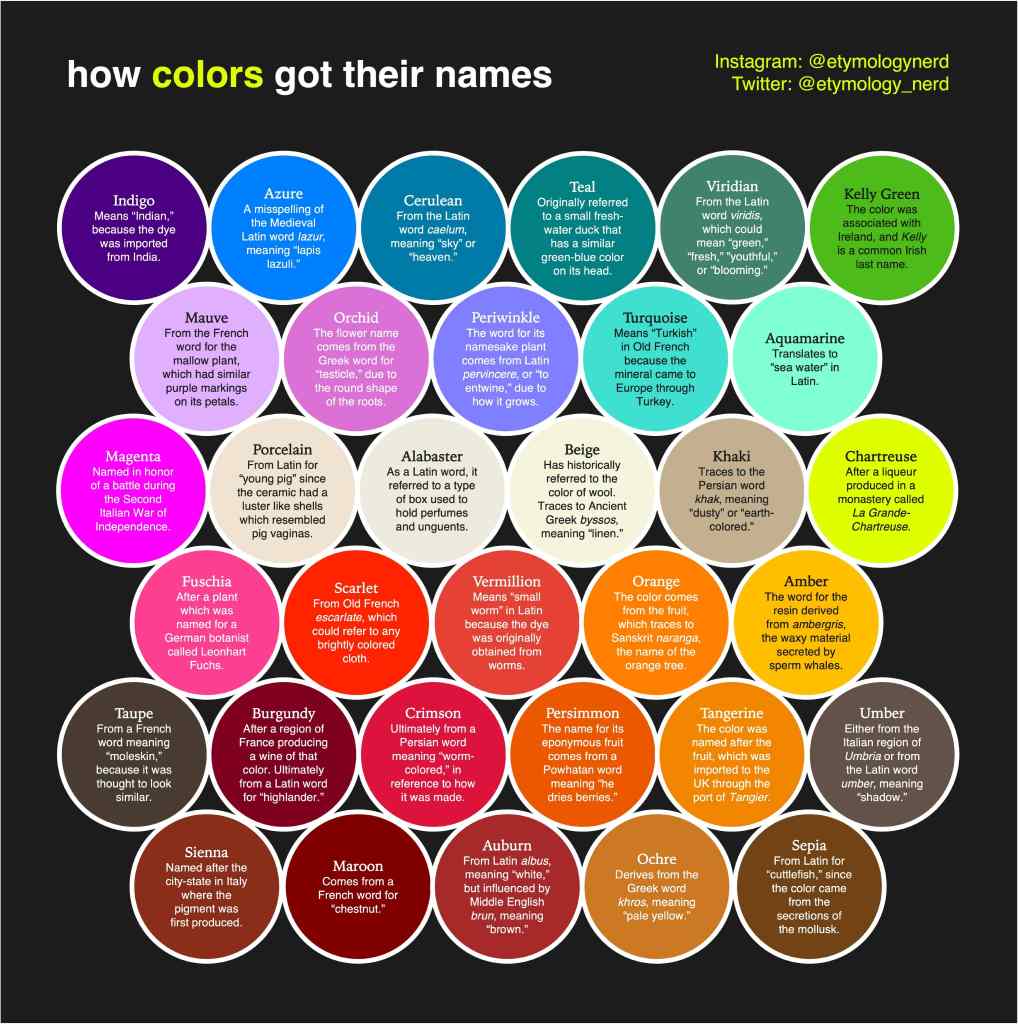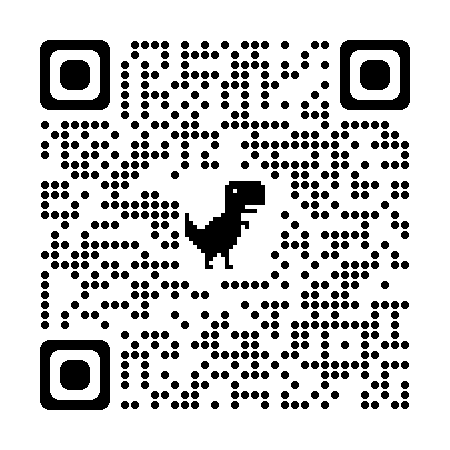Proud member and cooperative founder of the YouTube Channel «Proyectando Escuelas Amigas»

Check this image.
Here you can find unusual colours, their names, and their etymology (@etimology_nerd rules!).

I found it on the Internet and thought it could work miracles to discuss not-so-common colour names at advanced levels.
My proposal is: You present two sets of cards, one with the name and the etymology and another set with the colours (not the word, the colour) separately and students need to pair them up. Just as simple. If you cannot print the cards with the colours, you can use a set of cards with the name and another set with the etymology and then ask what shade students think they belong to.
Then, they can discuss the following:
Did you know any of these? What is your favourite colour range? Why? Do you know anyone who is colourblind? If so, what problems do they have?
Here you can find the texts extracted from the image together with the questions. Please, do not forget to MAKE YOUR OWN SELECTION of the colours you are going to use because a couple of them might not be appropriate. Click here to find any colour you need
Dejo por aquí la presentación que utilicé para la propuesta de elaboración de materiales para niveles C el pasado 20 de enero de 2023 en la EOI 1 de Zaragoza, en la Jornada de innovación educativa.
Just in case you wanted to give some context when students come up with doubt when you explain this structure.

Do your students make the same mistakes on and on? Are they really consistent in this area? Well, mine are. Somehow, some spelling mistakes sink in and I have found it really hard to get rid of them.
I have found this activity that is, in my opinion, both fun and memorable. You only need some paper, a pen, some thread, cards, and groups of three or four students willing to have fun.
How to
Write cards with the words you want to correct on them. In my groups, students tend to write writting*. Each group is given three or four cards.
They need to reflect on the mistake they usually make.
Finally, they need to write the word correctly as shown in the video.
These can be really useful for class!!!
This web shows how air flows physically!
And then, the following one is fantastic for class
News of the day… Lizz Truss couldn’t make it against the lettuce!
Inspired by a columnist’s turn of phrase, a British newspaper tracked whether the embattled prime minister could survive longer than a lettuce?
Watch the video
Discuss main ideas
Speaking task:
What do you think about this campaign?
Is it funny or is it cruel?
Why do you think this is happening to Lizz Truss?
Do you think politicians deserve this type of campaign?
Do you think such a campaign would be successful in your country/area? Can you think of anything similar happening in your country/area?
Apart from the obvious, what can you deduce that the British think about national politics right now?
Mediation task:
Student A reads text 1 while Student B reads text 2 Student C reads text 3 (this one is particularly difficult, I’d say only for C2) . They can work in bigger groups to prepare the text, as usual.
1.- Prepare to retell what you read. You need to take notes because you won’t be allowed to check the text.
2.- Choose and share (all the group members choose the same):
a word or expression you like and use
a word of expression you like but never use
something that was new to you
Remember, do not translate the vocabulary you chose. Try to explain it first.
3.- In pairs or groups of three, retell the text and share vocabulary.
And here’s what´s happened.
And here’s what the Daily Star did…
The channel broadcasts live at the moment, so look for the moment she resigned and the party begins.
An easy starter for a lesson about hobbies, or art, or music…
Screen the following image

How many of these groups do you know? Don’t say their names, just a number!!! In turns, give tips to your groupmates so they find out which ones you know.
What do you know about them?
Is any of them one of your personal favourites?
Are you into oldies when talking about music or do you fancy modern performers? If so, which groups do you prefer?
Now, discuss…
If you were granted a wish and you could choose to attend one of these concerts… which one would that be?
If your answer is none, who would you love to see perform?
Here is a set of images of some elderly people you might recognize. Artist Alper Yesiltas uses AI to create these images that might come in handy for a lesson.
It is a good warm-up. You can start telling the story of the secret island where very wealthy people who want to move away from the public eye go hide. They fake their own death and live happily ever after. But good things don’t last long and someone has uncovered their ploy…
Students are randomly given one of the pictures. They cannot tell who the person is, they need to keep it a secret!!! Then they build up a full story, as complete as possible, present it to the class and the rest need to guess who is who.
These images can also be used in a ‘What if…’ lesson plan to revise conditionals.
If Janis Joplin hadn’t died so early, she would have…
Pictures

Guess who?
You can also go for a Guess Who? game as a follow-up activity.










In case you had problems recognising these people (which would mean you are insultingly young), here you have the answers.
Retrieving what was learnt/taught in the previous lesson is always a bit of a problem for me, particularly as far as vocabulary is concerned. And so, I thought… what about a cutting-edge game??? As you all know, wordle has made some noise lately, so I decided to use it in class. Here’s what I do:
I have found this webpage https://mywordle.strivemath.com/ (thank you, Twitter) where you can create your own wordle. There are some languages to choose from but if yours is not there, you can select no dictionary.
For me, it has a plus because you can type in longer words, so you do not need to look for five-letter words. Once you’ve set it, you can embed it on your webpage/online platform or download a QR code.
I use it as a competition, so my students work individually and can check their notes. If they didn’t come to the previous lesson, they can work with somebody else. The first one to finish rings a bell.
You do not need to check since it self-corrects. And they revise all the vocabulary you taught in the previous session. It’s a win-win!!!
Here’s an example:
https://mywordle.strivemath.com/?word=kikvzynqv

A lesson plan to practice reading and listening comprehension, speaking, and critical thinking.
It needs to be done in groups, so students will have to discuss, suggest, agree…
It has three different paths that constantly intertwine. After each mission, students will have to retell the others what they have learnt and crack some kind of code together.
In an early stage, a couple of days before actually doing the activity, students will receive the following presentation to lift spirits and make them curious.
The escape room is planned for an online session with my blended learning group, but it is easily adaptable.
Tell your students they need to choose a character (A, B, or C) because what they are going to do is similar but not identical. And provide a valid form of communication, a chat in the videoconference room, i.e. because they might be confused at some point, and help needs to arrive fast.
Your role is going to be that of M, a supersecret senior agent that is there to help and give support.
Here is the full escape room.
KEYS:
DOOR #1 – THE GAME IS AFOOT
DOOR #2 – ALEA IACTA EST
PATTERN #1 GREY PENTAGON
PATTERN #2 RED OCTOGON
BRIEFCASE – 230